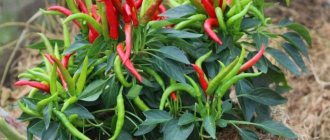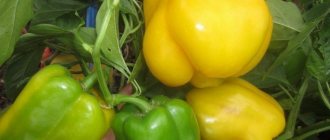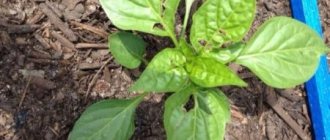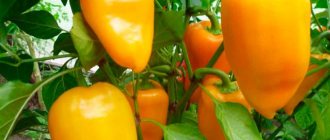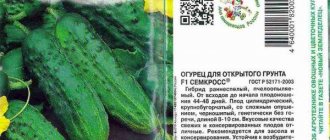In greenhouses, sweet bell peppers ripen faster and are guaranteed. You can easily grow tall bushes and get the first harvest from the earliest varieties of pepper. By choosing the best and most productive greenhouse varieties, you can get large, juicy and healthy peppers. There are also some peculiarities when growing peppers in a polycarbonate greenhouse.
The best varieties of peppers for greenhouses
Choosing the best varieties of pepper is quite difficult. Every gardener has his own “favorites”.
We suggest focusing on those varieties that produce decent yields, beautiful, tasty fruits and ripen in a short time.
We recommend the best pepper varieties for greenhouses:
- Agapovsky (1995),
- Atlant (2007),
- Bogatyr (1996)
- Chocolate Oriental Star (2006),
- Mastodon
Agapovsky |
The variety can be called the best for 3 reasons:
- the weight of the fruit reaches 120 g and on nutritious soil it can be even more,
- from germination to ripeness it can take only 98 days,
- This is a very compact plant.
The fruits are quite large for such a baby, have a bizarre prism shape and a smooth surface with barely visible ribs.
- Fully ripe peppers are scarlet in color.
- The number of nests varies from 3 to 4.
- The fruits are drooping with a wall thickness of up to 0.7 cm.
The taste is pretty good. The aroma is strong and pleasant.
| ADVICE The best way to protect tomatoes in a greenhouse from whiteflies is a hanging glue trap-screen “Mashenka”. Effective and safe, a reliable environmentally friendly way to control pests! |
Photo: effective glue trap “Mashenka” from insect pests in a greenhouse
Mastodon |
Harvest sweet pepper Mastodon, combining early ripeness with large juicy heavy fruits! Designed for cultivation in unheated and heated greenhouses.
The fruits are large, cuboidal, 3-chambered, weighing 200-270 g, measuring 12-13x9-11 cm, with a pericarp thickness of 6-7 mm, dark green in technical ripeness, red in biological ripeness.
- From germination to technical ripeness 105-125 days, to biological ripeness - 140 days.
- The bush is medium-sized, sparse, 140-180 cm high in unheated greenhouses.
- Planting density 3 plants/m².
It stands out for its stable harvest and high taste. Resistant to tobacco mosaic virus.
Order seeds directly
Photo: productive large-fruited Mastodon variety for the greenhouse
Atlant |
The variety has enough advantages to become the best.
- Fruit weight is about 190 g. The taste is excellent. The variety produces more than 3.5 kg of fruit per 1 m².
- The fruits themselves are drooping, cone-shaped and highly glossy. At biological ripeness, the fruits become bright scarlet.
- There can be from 3 to 4 nests. The wall thickness is 5.3 mm.
Peppers are good for consumption both fresh and for preparing any dishes, including hearty, tasty preparations for the winter.
Star of the East Chocolate |
The name itself seems to speak for itself. The pepper is tasty, juicy, unusual in color - a real star.
- The weight of mature dark brown peppers can reach 355 g.
- From every 1 m² you can collect more than 10 kg of fruit.
- All fruits are drooping, cylindrical in shape, with 2 or 3 nests.
- Wall thickness approx. 1 cm makes the pepper taste excellent. At the same time, the aroma is practically not felt.
The fruits are good for stuffing, pickling, in salads, stews, lecho and other dishes. For example, you can try recipes for preparing peppers for the winter.
Description of sweet pepper
Sweet pepper is a southern delicate plant that requires special conditions for growth. Therefore, garden lovers are recommended to plant it in greenhouses to obtain a fruitful harvest. The structures can be either polycarbonate, glass, or the usual ones familiar in everyday life - film.
The plant belongs to the annual vegetable plantings. As a rule, the bush grows on one stem, with leaves of various green shades collected in a rosette. Pepper fruits are often large, have different colors: from bright yellow to dark green, in some cases the pepper can be brown or striped. The color depends on the variety.
Beneficial features
- It has many useful components, such as silicon, iron, vitamins P and C. In terms of their content, it undoubtedly occupies one of the leading places. If you use it often, you can put blood vessels in order and improve heart function.
Bell pepper
- Sweet peppers contain an original substance that is extremely rare to find: capsoicin. It helps improve appetite and also activates the digestive process. But most of this substance is found in hot chili pepper and black pepper (peas).
- Healing effect for the entire human body. Daily consumption of sweet peppers will reduce the risk of malignant neoplasms, especially breast tumors. Therefore, this vegetable is preferable for women to eat.
- It has excellent taste. Everything here speaks for itself. Any dish to which at least a little bell pepper is added will only benefit from it. But everything should be used in moderation so as not to spoil the preparations.
Yield varieties of peppers for greenhouses
In a greenhouse, you can create and regulate the most favorable conditions for growing peppers. Suitable temperature, humidity and light conditions, sufficient mineral and organic nutrition will allow you to obtain record and guaranteed yields.
| The most productive greenhouse pepper varieties produce more than 14 kg of fruit per 1 m² |
Among these generous varieties are:
- Atlant (2007),
- ox ear (2007),
- Gemini (2007),
- Latino (2012).
Latino |
An outstanding hybrid with a fruit weight of 240 g, and maybe more if you follow all the recommendations of agricultural technology.
- The fruit has a drooping, cube-shaped shape, red or dark red in color when biologically ripe.
- The number of nests varies from 3 to 4.
- With a fruit weight of 240 g, the wall thickness can be slightly more than 1 cm, the yield with such a mass is slightly more than 14 kg per 1 m².
The bush ripens early, is slightly spreading and not very tall, the taste of the fruit is excellent.
Jackmini |
The ripening period is mid-early, the plant itself is semi-spreading with drooping fruits, cylindrical in shape and glossy in color.
- The variety is distinguished by fruits with a maximum weight of 206 g. At the same time, it is guaranteed to produce 14.3 kg per 1 m².
- For this, the soil needs to be nutritious and fully cared for according to all the rules.
- At biological ripeness, the fruit is deep yellow.
- The number of nests can be 2 or 3, and the thickness of the fruit wall is about 0.7 cm.
The taste is excellent. Peppers exhibit all their taste perfectly both fresh and in any processing.
ox ear |
Among the productive varieties, this representative has the most modest fruit in size.
- With a pepper mass of 200 g, the yield is still at least 14 kg per 1 m².
- The variety is characterized by mid-ripening, spreading bush shape and low height.
- The fruits are drooping, shiny, and cone-shaped.
- Biologically ripe fruits are bright red.
- Wall thickness is about 0.7 cm.
The taste is wonderful. The fruits are suitable for salads, preparations and hot dishes.
Diseases and pests of sweet pepper
Vegetable crops, like all other garden plants, can be susceptible to attack by harmful insects or many diseases common in the climatic region where sweet peppers grow. Pests, the same as those of tomatoes, are cutworms, whiteflies, and the most common disease is dry blossom end rot or fusarium.
Pepper diseases and pests
The first disease is more dangerous, since small spots first appear on the peppercorn, which then smoothly turn into large islands that affect the entire fruit. The sweet pepper gradually dries out, leaving only a thin crust.
Sweet pepper diseases and ways to combat them
To prevent this from happening, you must follow simple rules of care:
Weeding beds
Pepper varieties for polycarbonate greenhouses
Polycarbonate greenhouses are widespread, they are affordable and popular among summer residents in different regions. Relatively inexpensive, yet strong and durable, they are perfectly suited for growing vegetables even in cold, short, rainy summers. At the same time, a significant disadvantage of polycarbonate greenhouses is the high level of heating under direct sunlight. Therefore, plants intended for growing in polycarbonate greenhouses should tolerate elevated temperatures without problems. At the same time, do not forget to regularly ventilate the greenhouses.
Among the peppers adapted for hot polycarbonate greenhouses, we can recommend the following varieties:
- Orange miracle (2012),
- Tenderness (1986),
- Night (1999)
- Victoria (1979).
Orange miracle
Early ripening hybrid, small in height. The fruits are drooping and cube-shaped. Peppers at biological ripeness become a rich orange color. The number of nests varies from 3 to 4. The weight of the fruit can reach 213 g with a wall thickness of almost 1 cm. The taste is excellent. Productivity is approximately 10 kg 1 m².
Night
The variety is ideally suited for growing in any polycarbonate greenhouse. The fruits taste best when fresh. The variety is distinguished by its late ripening; you will have to wait for the fruits for as long as 135 days from the emergence of seedlings after sowing the seeds. This is a standard plant, reaching one and a half meters in height. The fruits are prism-shaped, with small waves on the surface and barely noticeable ribs. The fruit is slightly curved and has a blunt tip. Peppers at biological ripeness turn red. The number of nests varies from 3 to 4. The weight of each fruit is slightly more than 140 g with a fruit wall thickness of about 0.7 cm. The taste is excellent, but the aroma is practically absent. The yield per square meter reaches 7.4 kilograms.
Victoria
The variety is suitable for growing in a polycarbonate greenhouse. Early ripening: peppers will ripen in 133 days and acquire an interesting light green hue. The height of the plant rarely exceeds 60 cm. The fruits are of the hanging type, almost perfectly cone-shaped and quite smooth. The weight of each fruit can exceed 75 g, and the wall thickness is at around 0.6 cm. The taste of the fruit is very good. The yield is slightly more than 2 kg per 1 m².
Basic selection options
Pepper is a very heat-loving plant, demanding light and humidity, and has a long growing season. In the agroclimatic conditions of Russia, including in the southern regions, it is usually cultivated by seedlings, planting seedlings at 60-70 days of age in a permanent place. The timing of planting seedlings is determined depending on the type of greenhouse structure and its technical equipment. Caring for peppers in a greenhouse includes maintaining optimal temperature, watering, fertilizing, loosening the soil, plant formation, stimulating self-pollination during the flowering period, and protecting against diseases and pests.
Maximum results when planting in open ground are possible mainly in regions with long and warm summers
In conditions of sharply and moderately continental climates, including in the Urals and Siberia, amateur vegetable growers create favorable conditions for pepper in protected soil - greenhouses (winter or unheated) and hotbeds.
The yield and marketability of fruits depend on the variety, as well as weather and climatic factors, the mechanical and chemical composition of the soil, and the intensity of agricultural technology used.
As of 2022, the State Register of the Russian Federation includes:
| Type of culture | Quantity | Explanation |
| Hot pepper | 119 varieties and hybrids | Designed for cultivation on private farms throughout the country, suitable for both open and closed ground |
| Sweet pepper | 905 varieties and hybrids | More than 150 of them are recommended for cultivation exclusively in protected soil conditions |
The range of seed material available for sale is much wider and includes not only officially recognized varieties, but also varieties of unknown origin. In order not to become a victim of unfair advertising when purchasing, it is safer to choose and purchase seeds in specialized stores, on the websites of reputable nurseries and agricultural companies that have the appropriate license (SeDeK, Poisk, Aelita, Gavrish, etc.) , or scientific agricultural institutions (FGBI FNTSO, etc.).
Just 40 years ago, sweet pepper, also known as bell pepper, was a relatively rare crop. The first variety bred by domestic breeders specifically for indoor soil was “Winnie the Pooh” (included in the State Register of the Russian Federation in 1981).
Winnie the Pooh plants are short (20-30 cm), compact, in greenhouse conditions the fruits reach technical maturity in 107-111 days
The owners of buildings of this type consider the most suitable varieties of peppers for polycarbonate greenhouses to be: “Swallow”, “Pioneer”, “Crystal”, “Victoria”, “Kolobok”, “Gift of Moldova”, “Atlant”, “Orange Miracle”. In addition, the achievements of foreign selection are very popular: the Dutch “Danub”, the American “Bell Goy” and the Bulgarian “Bila Kapia”.
Despite the high cost of polycarbonate greenhouses, their design has a number of advantages:
- maximum sunlight transmission;
- resistance to mechanical damage;
- plasticity of the material, that is, the structure can be given any shape;
- high resistance to moisture and temperature changes;
- service life more than 20 years;
- attractive appearance.
Over the past decades, many domestic and foreign new products have appeared, intended for cultivation in a greenhouse, which have proven themselves well both in Russia and in other post-Soviet countries. When choosing pepper varieties for indoor soil, amateur vegetable growers give preference to early-ripening ones that form a small compact bush. You can learn about the specifics of their cultivation from the following video:
Professional farmers are more likely to plant tall varieties to make better use of vertical space and produce larger yields. A Ukrainian vegetable grower tells in detail about the greenhouse cultivation of tall pepper “Solomon F1” and the peculiarities of its tying:
Early varieties of pepper for greenhouses
When planting the earliest varieties of pepper in a greenhouse, you can expect the first harvest less than 100 years after emergence. In the group of early peppers, the following varieties can be distinguished:
- Agapovsky (1995),
- Yarik (2004),
- Pinocchio (1995)
- Health (1986).
Pinocchio
The Buratino variety is the earliest of those named. The harvest will delight you after just 88 days. Semi-determinate plant with large peppers, elongated cone-shaped with barely noticeable ribbing on the surface, dark green in color. The fruits are drooping, the weight reaches 116 g, and the wall thickness is 0.5 cm. The taste is quite decent. The yield per 1 m² reaches a record of 13.5 kg.
Yarik
To ripen this variety it will take approx. 95 days. It can be eaten fresh or used in cooking. The plant has a semi-standard type, drooping cone-shaped fruits, glossy and yellow in color. The number of nests can be 2 or 3, and the weight of the fruit reaches 60 g with a wall thickness of 0.4 cm. The taste of the variety is excellent. Productivity reaches 4.7 kg per 1 m².
Agapovsky
The variety will delight you with the first harvest in 99 days. The plant itself is quite compact, the fruits are very large, prism-shaped, with a smooth surface, slight ribbing and red coloring. The fruits on the plant are drooping, the number of nests can be either three or four, and the weight of the fruit on good soil reaches 123 g. The wall thickness is close to 1 cm. The taste of the fruit is very pleasant, a strong aroma is felt. From every 1 m² you can collect up to 10.5 kg of fruit.
Growing early peppers
Growing early varieties of peppers is not at all difficult, and even a novice gardener can do it. Here you need to follow some recommendations, and then success is guaranteed.
Choosing a variety for planting
We choose early pepper seeds zoned for your region. It is also important to decide where we will grow the pepper. For example, in a greenhouse, greenhouse or open ground. And yet, it is important to understand for what purpose we will grow it (fresh consumption, preservation, stuffing, storage).
Seed preparation
Seeds can be contaminated, and to prevent disease, seeds must be properly prepared for planting. Important
: Hybrid seeds from the store can be planted immediately, you don’t need to do anything with them.
- Seed disinfection. Place the seeds in a solution of potassium permanganate for 20 minutes.
- The seeds must be soaked for 24 - 48 hours. Here, keep the seeds in a damp cloth (gauze). It will also be useful to soak the seeds in growth stimulants such as humate, epin or zircon.
Planting seedlings
- Prepared seeds are planted in separate pots or containers. The planting depth is 1.5 cm. Between the rows there are 4 cm. In the row between the seeds there is 1 cm. By the way
, when planting, 2 seeds are planted in separate cups. - Next, fill the soil mixture with a layer of 1 cm - 1.5 cm. Then lightly compact it and carefully water it with a spray bottle. Cover with glass and place in a warm place. We are waiting for the shoots.
Seedling care
Watering
. Excess moisture, as well as lack of moisture, negatively affects plants. Water as it dries with warm, settled water.
Temperature
. After complete germination, we keep the temperature at 21 ° C - 22 ° C during the daytime, and at night 15 ° C - 16 ° C. And so on for a week. After this, during the day we keep it at 23 °C - 26 °C, and at night 16 °C - 18 °C.
Light mode
. We illuminate the seedlings with phytolamps for 2 - 3 weeks (in the mornings and evenings).
Feeding
. We feed the seedlings 2-3 times before planting them in the ground.
Hardening off plants
. We begin hardening 2 weeks before planting. We do everything gradually. First, we take it out onto the loggia for a short time, and then we increase this time.
Planting in open ground
We make holes in the prepared bed according to a pattern of 35 cm by 45 cm, here 45 cm is the distance between the rows. Important
: These distances depend on the variety. For example, for short peppers they are smaller, and for tall peppers they are larger.
Next, we bury the seedlings down to the cotyledon leaves, fill them in and carefully water them.
Caring for peppers in the garden
- Watering. For the first ten days after planting in the ground, we water it every day. And then, 2 times a week. The water should be warm and settled.
- Feeding. Once a week with organic solutions or use complex fertilizers.
- Formation of plants. There is no need to do anything with the short ones. And taller ones lead to 1 - 3 stems.
- Loosening. The soil needs to be loosened. We combine the process with watering, fertilizing and weeding. You can mulch the soil.
- Prevention from diseases. Proper agricultural technology: crop rotation, preparation of seeds and soil, preventive work.
Good luck to you!
Tall varieties of peppers for greenhouses
In tall greenhouse-houses it is convenient to grow indeterminate bushes with unlimited growth. Among tall varieties, I consider the most successful varieties to be:
- Merchant (2001),
- Snegirek (1998),
- Medal (1992)
- Fiery (1998).
Snegirek
Among tall bushes it is considered the undisputed leader, growing up to 210 cm tall than a person. An early ripening variety, it will delight you with a harvest after 105 days. The position of the fruits on the plant is drooping, they have a prism-shaped shape and a smooth surface, glossy in appearance, slightly curved, the ribbing is also not clearly expressed, and are red in color at biological ripeness. There can be from 2 to 4 nests with a fruit weight reaching 125 g and a wall thickness of 0.75 cm. The taste is very good, but the aroma is rather weak. Productivity reaches 13.2 kg per 1 m².
Fiery
The Flame variety is a little lower, “only” 180 cm, although it is also early ripening and its fruits will ripen within 102 days after germination. The fruits are also in a drooping state; they are prism-shaped, slightly wavy, and the ribbing is very weakly expressed. At biological ripeness, the fruits are red with a blunt tip. The weight of the fruit on good soil can reach 101 g, and the wall thickness can reach 0.6 cm. The taste of the fruit pulp is very pleasant, the aroma is strong and persistent. Productivity reaches 12.4 kg per 1 m².
Merchant
Merchant is the lowest of the presented group of tall varieties, reaching at least 85 cm. It is excellent for fresh consumption, canning, stuffing, etc. It is interesting to try a dietary recipe for peppers with minced vegetables. The fruit itself is drooping, cylindrical in shape and has a smooth, glossy surface. At biological ripeness, the fruit is red. The number of nests can be from 2 to 3, and the wall thickness can reach almost 1 cm. The maximum weight of the fruit on good soil often exceeds 130 g. The fruits are very tasty, with a pleasant aroma. The yield from 1 m² reaches 3 kg.
Pure variety or hybrid
To make it easier to make a choice, let’s talk about the differences between pure and hybrid plant samples.
Early varieties grow much better in a greenhouse than in open ground.
Pure varieties are the result of long-term, high-quality seed selection. Farmers grow plants, then select the best ones:
- the highest;
- the most meaty;
- with the most delicious and largest fruits.
The seeds are removed from the fruits of this plant. Then the seedlings are planted by hand. The qualifying round is repeated until the result is perfect. This is how a pure variety appears.
Attention! As a rule, such peppers grow in certain regions and require careful care.
Ultra-early ripening sweet pepper hybrids are the result of crossing early varieties in greenhouses. These plant samples differ:
- thick stem;
- high yield;
- quality fruits;
- attractive appearance;
- compactness of the bush;
- endurance to diseases;
- resistance to pests.
Important! The seeds of an early hybrid sweet pepper variety grown in a greenhouse do not retain genetics.
In other words, they are disposable. To plant next year you will need to purchase new seeds. At the same time, their considerable cost should be taken into account.
Peppers with the most beautiful fruits
But if not only the taste of the fruit is important to you, but also its appearance, then the following varieties are for you:
- Orange miracle F1. The large, glossy, cube-shaped, orange fruits of this plant look like toys. In addition, the species is high-yielding and early ripening.
- Chocolate F1. chocolate -colored plump fruits , then choose this plant. The variety has excellent immunity, taste and aroma.
- Hidalgo F1. If you like the color yellow, then this is the plant for you. Large, fleshy fruits have a sweet taste. Peppers ripen within 120 days.
Favorite Dutch varieties
For those summer residents who prefer varieties from Holland, we can offer:
- Eroshka. This plant is distinguished by large, orange fruits on a low bush. It is distinguished by its early ripening and resistance to cold weather.
- Funtik. Early ripening variety. The bushes are tall and require support. The fruits are large, red, in the form of a truncated cone. The plant requires prevention from spider mites.
- Corvette. The low-growing bush is strewn with fleshy, fragrant, orange fruits. The peppers are small, weighing up to 90 grams. Early ripening variety.
According to ripening time
In order to be able to enjoy delicious, fresh peppers from your garden throughout the summer season, you should plant varieties with different ripening periods.
Ultra-early ripening
The very first fruits can be collected from these ultra-early varieties of sweet peppers:
- Tamara F1. The growing season of this ultra-early hybrid lasts only 65 days. The bushes are small and compact. The fruits are medium, juicy and tasty. The species tolerates minor cold snaps well.
- Sonata F1. The fruits of this high-yielding hybrid can be harvested after 70 days. Peppers weigh on average 200 grams. The variety is unpretentious and resistant to diseases.
- Caliph F1. Already 55-60 days after germination, you can enjoy the delicious fruits of this variety. Peppers are initially white in color, but as they ripen they turn red. Although the species is quite cold-resistant, it is still best to grow it in greenhouses.
Early
By the end of June, the fruits of these early varieties of bell pepper begin to ripen:
- Triton. The species has small bushes and therefore does not require staking or pruning. The fruits are medium, weighing 150 g, red.
- Merchant. The growth of the plant reaches 85-90 cm and for this reason it requires a garter to a support. This variety is loved not only for its early ripening, but also because of the stable, large harvest of red peppers.
- Montero. The harvest of this hybrid will take a little more than 3 months . The fruits are medium, weighing 120-130 g. From one bush you can collect 2 kg of peppers.
Medium ripening
From the beginning of the second half of summer, we begin to harvest from mid-season varieties; their growing season lasts about 110-130 days:
- Pepper Anastasia. The height of the plant is 75-80 cm, the yield is small - 4-5 kg per square. The fruits are tasty, juicy, weighing 230-250 g.
- Fatty. Thick-walled (1cm) fruits weighing 200 grams are red in biological ripeness. Pepper is valued for its high content of vitamin C. The plant is not tall - 55-60 cm. Productivity is up to 5 kg per square.
- Isabel. A productive hybrid with large and thick-walled fruits. The bush is compact, 60 cm in height. The weight of pepper is 130-150 g; from one bush you can collect 5 kg per season.
Late
Such varieties begin to bear fruit after 130 days, towards the very end of summer. Of the late-ripening peppers, it is worth noting:
- Hercules. The fruit harvest period is 135-150 days from germination. Peppers weigh 150-180 grams and are red when fully ripe.
- Marshmallow. Such a plant should only be grown in greenhouses where the temperature does not drop to zero. Vegetables fully ripen by the beginning of autumn and are red in color and weigh 150-180 grams. The pulp is tasty and crispy. The bushes do not require a garter.
- Bogatyr. Tall and spreading bushes of this species need support. The growing season of the plant is about 4 months, the peppers weigh 200 grams and are scarlet in color.
Reviews from gardeners about popular varieties
At the moment, in the State Register there is a large assortment of good varieties of peppers for greenhouses. Every summer resident can find exactly those species that will delight him with their rich harvests.
Tatiana, Tula:
I have been growing my favorite varieties in my greenhouse for a long time: California Miracle, Atlant, Lastochka. I have never been left without a harvest. I start picking peppers by the end of June.
Natalya, Novgorod:
Last year I planted Apricot favorite for the first time. From six bushes I provided my entire large family with peppers for a whole year. This year I have already purchased seeds of this variety.
Nikolay, Kemerovo:
My favorite varieties for the greenhouse have remained the same for many years. These are Barguzin, Bogatyr, Atlas, Cardinal. I trust these guys, and they have never let me down with the harvest.


